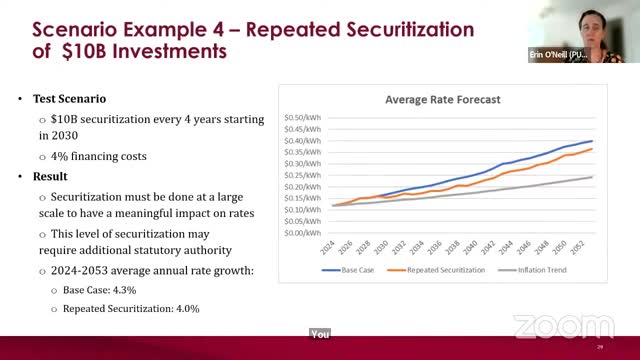Colorado explores aggressive solar growth to cut rates
July 26, 2024 | Public Utilities Commission, Governor's Boards and Commissions, Organizations, Executive, Colorado

This article was created by AI summarizing key points discussed. AI makes mistakes, so for full details and context, please refer to the video of the full meeting. Please report any errors so we can fix them. Report an error »

In a recent government meeting, officials discussed a significant financial strategy involving the securitization of $10 billion worth of rate base every four years. This approach aims to manage the growing rate base, projected to increase by $17 billion every five years. By adopting this securitization strategy, the financing cost is anticipated to be around 4%, compared to the weighted average cost of capital (WACC) of approximately 7%. This shift could reduce the annual growth rate from 4.3% to 4%, although it does not fully align with inflation rates.
The discussion highlighted that the securitization of various rate-based assets may necessitate statutory changes, indicating potential legal complexities in implementing this financial strategy.
Additionally, the meeting addressed the current state of net metering penetration in Colorado, which stands at about 4-5% for behind-the-meter solar installations, significantly lower than California's 12%. Officials explored two scenarios for increasing solar penetration in Colorado. The first scenario suggests doubling the current rate of solar adoption, potentially reaching California's current level by 2034. The second, more aggressive scenario aims for a 16% penetration by 2034, positioning Colorado to match California's current solar adoption by 2030.
These discussions underscore the state's efforts to enhance its renewable energy landscape while managing financial implications associated with rate base growth and solar energy adoption.
The discussion highlighted that the securitization of various rate-based assets may necessitate statutory changes, indicating potential legal complexities in implementing this financial strategy.
Additionally, the meeting addressed the current state of net metering penetration in Colorado, which stands at about 4-5% for behind-the-meter solar installations, significantly lower than California's 12%. Officials explored two scenarios for increasing solar penetration in Colorado. The first scenario suggests doubling the current rate of solar adoption, potentially reaching California's current level by 2034. The second, more aggressive scenario aims for a 16% penetration by 2034, positioning Colorado to match California's current solar adoption by 2030.
These discussions underscore the state's efforts to enhance its renewable energy landscape while managing financial implications associated with rate base growth and solar energy adoption.
View full meeting
This article is based on a recent meeting—watch the full video and explore the complete transcript for deeper insights into the discussion.
View full meeting
